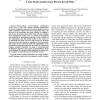HICSS
2011
IEEE
13 years 9 months ago
2011
IEEE
Although our society is critically dependent on software systems, these systems are mainly secured by protection mechanisms during operation instead of considering security issues...
SOCA
2010
IEEE
14 years 3 months ago
2010
IEEE
Process-driven service-oriented architectures (SOA) need to cope with constant changing requirements of various compliance requirements, such as quality of service (QoS) constraint...
ISF
2007
2007
Requirements traceability in model-driven development: Applying model and transformation conformance
14 years 5 months ago
The variety of design artifacts (models) produced in a model-driven design process results in an intricate relationship between requirements and the various models. This paper prop...
GG
2010
Springer
14 years 6 months ago
2010
Springer
Model-driven development (MDD) has become a promising trend in software engineering. The model-driven development of highly complex software systems may lead to large models which ...
SERP
2004
14 years 7 months ago
2004
Model-Driven Development (MDD) represents a positive step toward a general model-based approach to software engineering. The Object Management Group (OMG) offers a conceptual fram...
VAMOS
2010
Springer
14 years 7 months ago
2010
Springer
Model-driven development of software-intensive systems aims at designing systems by stepwise model refinement. In order to create software product lines by model-driven development...
CSREAESA
2008
14 years 7 months ago
2008
To deal with the increasing complexity of embedded real-time systems the model-driven development approach has proven to be beneficial. The reduction of complexity achieved by the ...
APCCM
2008
14 years 7 months ago
2008
Model-driven development is the process of creating models of a software system and transforming them into source code. Since the stepwise transformations can be done automaticall...
FASE
2008
Springer
14 years 7 months ago
2008
Springer
With the success of model-driven development as well as component-based and service-oriented systems, models of software architecture are key artefacts in the development process. ...
FASE
2008
Springer
14 years 7 months ago
2008
Springer
Abstract. Model-driven development is a field within software engineering in which software artifacts are represented as models in order to improve productivity, quality, and cost ...




